Russian Black Pied Cattle
 The Black Pied breed developed from crossing the local cattle in various areas with
the Dutch Black Pied and East Friesian breeds. Pure breeding of Dutch cattle in Russia
was conducted on only a small scale. The central, Ukrainian, Siberian and other strains
of Black Pied cattle were formed by adsorptive and reproductive crossing.
The Black Pied breed developed from crossing the local cattle in various areas with
the Dutch Black Pied and East Friesian breeds. Pure breeding of Dutch cattle in Russia
was conducted on only a small scale. The central, Ukrainian, Siberian and other strains
of Black Pied cattle were formed by adsorptive and reproductive crossing.
The various strains of Black Pied cattle were approved as a planned breed in 1925. Therefore, some animals were imported from Germany, the Netherlands, Estonia and Lithuania during 1930-40 and distributed in various parts of the country. The imported sires improved milk production, feed conversion efficiency, and beef qualities. Five thousand head of the Dutch breed were imported during 1957-65. The production of the female ancestors of 107 bulls was 6-7000 kg of milk with butterfat content of 4.4-4.6%.
The Black Pied breed is noted for high milk production (the highest among the dairy breeds), good conformation and good beef qualities. Due to the high productivity, adjustment to machine milking, well-defined beef features and the ability to acclimatize, the population of this breed is increasing year by year. By the beginning of 1980 the number of Black Pied cattle in the USSR was 16 449 000 excluding the Baltic population. In numbers they are second (25.2%) among 50 cattle breeds in the country.
The Black Pied breed includes varied groups of animals, originating from different maternal stocks under different climatic and feeding conditions. The crossing of the local low-grade cattle - Great Russian, Siberian, Trans-Ural, Central Asian, Grey Ukranian - with Dutch bulls started at different times. The basic aim was to form a breed adapted to many different regions but originating from a single foundation breed. This unified breed was recognized in 1959.
 The Black Pied breed comprises five large populations: Central (mid-Russian), Baltic,
Ural, Siberian, and other zones, namely Ukraine, Byelorussia, Central Asia, and parts
of Transcaucasia.
The Black Pied breed comprises five large populations: Central (mid-Russian), Baltic,
Ural, Siberian, and other zones, namely Ukraine, Byelorussia, Central Asia, and parts
of Transcaucasia.
The animals of the Central group are the largest (live weight 550-650 kg), with a more compact conformation, relatively short legged and a good exterior appearance. This group is noted for the highest milk production (5500-6500 kg) with low butterfat content (3.6-3.7%).
On the other hand, the Ural strain is of a lighter, fine-boned solid type (500-600 kg live weight) with longer legs, less pronounced beef features, and high milk yield (5000-6000 kg) and butterfat content (3.8-3.9%).
The Siberian strain is an even lighter type (450-550 kg), with good milk yield (4500-5000 kg) and medium butterfat content (3.7-3.8%).
The remaining groups are intermediate between the three leading strains. The Baltic population
A network of selection centers was set up in the USSR in 1975. The All-Union Research Institute for Livestock Breeding and Genetics has become the center for work with the Black Pied breed. It unites the breeding activities of the leading breeding stations and zonal institutions that deal with this breed. The main goal of this selection center is to breed highly productive strains, types, herds, and lines of the Black Pied breed, by raising valuable sires for the A.I. stations, progeny testing them, storing semen of the improved sires, and using it for improving the great mass of the Black Pied cattle.
The comprehensive measures undertaken have made it possible to improve the productivity and the pedigree value of the Black Pied cattle in the working zones of the selection centers. The principal indicators of the activity of the breeding farms are the number and quality of the pedigree young stock produced and primarily of the sires. Realization in the last 15 years of this large-scale selection program has allowed a new approach to line breeding of the Black Pied cattle. In the breeding herds, bulls are produced by intra-line assortative mating with the use of moderate inbreeding. In the commercial farms the breeding activities are confined to the rotational crossing of lines within the breed. This increases the productivity, viability and fertility of the offspring.
The successful use of selection to breed, assess and use the better genotypes assisted in the formation of highly productive herds of the national Black Pied cattle. The average milk yield of 11 100 cows of the leading herds surveyed in various regions of the RSFSR in 1984 was 5559 kg, with a butterfat content of 3.82%. The best breeding stations are as follows: Petrovski in Leningrad region (1080 cows, 6671 kg milk, 3.91% butterfat); Lesnoye (750 cows, 6604 milk, 3.89% butterfat); Petrovskoye in Moscow region (750 cows, 5630 kg, 3.94% ); Zarya Ko izma in the same region (3150 cows, 5450 kg, 3.78%); Imeni Lenina collective farm in Tula region (1000 cows, 5480 kg, 3.90%).
The milk production of the champion Black Pied cows with a milk yield per lactation of over 10 000 kg and with a lifetime production of 90-100 000 kg points to the high potential of this breed. At the six base farms of the All-Union Institute of Animal Breeding and Genetics alone over 100 cows with a milk production of 10 000 kg or more have been bred.
In Sverdlovsk region the milk yield of over 22 000 cows was 4800-5000 kg with 3.86-3.90% fat. At the leading breeding stations over 240 cows have a yield of 6500-7500 kg of including 206 cows with a yield of over 7000 kg.
The milk production of the best cows on the farms of the Ural area is as follows: Aida 220 (the record holder for lifetime production) produced in 13 lactations 117 720 kg of milk with a butterfat content of 3.75%, or 4415 kg of milk fat; she belongs to the stud farm No. 9 of Perm region. Cow Volga 3790, in her 3rd lactation produced 17 517 kg of milk with 4.20% butterfat; she was kept at Rossiya breeding center in Chelyabinsk region. Gornaya 6329 at the same farm - 5th, 13 849 kg, 4.10%; Yagoda 6010 - 3rd, 13 146 kg, 3.93%.
The Black Pied breed accounts for the greatest numbers of champions with milk yields over 10,000 kg - 79 out of 212.
The breeding program of the Black Pied breed aims to produce a type with a milk yield of 6.0-7.5 thousand kg, butterfat content 3.8-3.9%, live weight of cows not less than 600 kg, udder index of 43-45% and milk flow speed of 2.0-2.5 kg per minute by using Holstein-Friesian sires from the U.S.A. and Canada. By the beginning of 1985, the basic numbers of highly productive halfbreds were bred at the leading breeding centers namely: Lesnoe and Petrovski in Leningrad region, Zarya Kommunizma in Moscow region and at Imeni Lenina collective farm in Tula region. Valuable sires have been bred in these Herds as well.
The best cows at the leading farms of the selection center are united in the super-elite group. The milk production of these animals is 6.2-7.7 000 kg with a butterfat content of 3.99-4.27%. They are used to produce replacement bull calves.
The breeding establishments of this country have valuable sires. The milk production of their dams and of the female ancestors of their sires ranges from 6250 to 8300 kg with butterfat content 3.99-4.48%. The major suppliers of the replacement bulls for the breeding centers are the farms of Moscow, Leningrad, Perm, Chelyabinsk, and Sverdlovsk regions. Bulls of more than 70 related groups and lines are currently in use; 45 of them are represented by small numbers of descendants and have only local importance. The sires of the lines Rikus 25415 (16.5%), Poseidon 239, and Oreshek 1 are widely used among the national lines. The descendants of the well-known Dutch bull Annnas Adema 30587 through the related groups of Keimpe 48326/43454 (21.7%) and Frizo Vouter 44116 (8.4%) have been widely distributed (30.1%).
Studies at the breeding station Lesnoye and at the breeding farm Torosovo in the Leningrad region have shown that selection has had only a minor effect on the frequency of specific erythrocyte antigens. This relative stability suggests that these polymorphisms are of adaptive significance.
References
Dmitriez, N.G. and Ernst, L.K. (1989) Animal Genetic Resources of the USSR. Animal Production and Health Paper Publ. by FAO, Rome, 517 pp.
